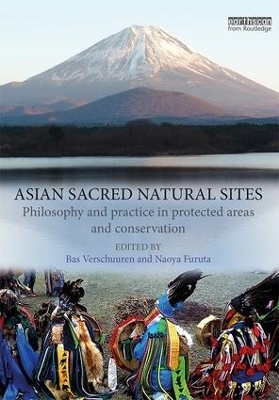
Asian Sacred Natural Sites
Routledge (Verlag)
978-1-138-93631-7 (ISBN)
Nature conservation planning tends to be driven by models based on Western norms and science, but these may not represent the cultural, philosophical and religious contexts of much of Asia. This book provides a new perspective on the topic of sacred natural sites and cultural heritage by linking Asian cultures, religions and worldviews with contemporary conservation practices and approaches.
The chapters focus on the modern significance of sacred natural sites in Asian protected areas with reference, where appropriate, to an Asian philosophy of protected areas. Drawn from over 20 different countries, the book covers examples of sacred natural sites from all of IUCN’s protected area categories and governance types. The authors demonstrate the challenges faced to maintain culture and support spiritual and religious governance and management structures in the face of strong modernisation across Asia.
The book shows how sacred natural sites contribute to defining new, more sustainable and more equitable forms of protected areas and conservation that reflect the worldviews and beliefs of their respective cultures and religions. The book contributes to a paradigm-shift in conservation and protected areas as it advocates for greater recognition of culture and spirituality through the adoption of biocultural conservation approaches.
Bas Verschuuren is a freelance conservation adviser and an associate researcher at the Department of Sociology of Development and Change at Wageningen University, the Netherlands. He is co-chair to the IUCN-WCPA Specialist Group on Cultural and Spiritual Values of Protected Areas and co-founder of the Sacred Natural Sites Initiative. Naoya Furuta is Coordinator at IUCN Japan Liaison Office and a professor at the Institute of Regional Development at Taisho University in Tokyo, Japan. He is a long-time member of Biodiversity Network Japan and also a member of the World Commission on Protected Areas.
1. Introduction: Re-awakening the Power of Place: Ancient Philosophy and Practice with Current Relevance for Protected Areas and Conservation in Asia Bas Verschuuren Section 1: Themes and Perspectives on the Conservation of Asian Sacred Natural Sites 2. The Asian Philosophy of Protected Areas Amran Hamzah 3. Sacred Mountains in Asia: Themes and Implications for Protected Areas Edwin Bernbaum 4. Can World Heritage Status Help Protect Sacred Sites in Asia? Alison Ormsby, Wendy Jackson and Shonil Bhagwat Section 2: National Perspectives and Strategies for the Conservation of Sacred Natural Sites 5. Sacred Mandala: Protecting Bhutan’s Sacred Natural Sites Liza Zogib, Khenpo Phuntshok Tashi, Tshewang Gyalpo, Sangay Dendhup, Riamsara Kuyakanon, Kelzang Wangchuk, Lopen Namgay Tenzin and Ngawang Gyeltshen 6. Indian Sacred Natural Sites: Ancient Traditions of Reverence and Conservation Explained from a Hindu Perspective Rana P.B. Singh and Pravin S. Rana 7. Interface between Sacred Natural Sites and Formal Protected Areas for Biodiversity Conservation in Nepal Jailab Kumar Rai and Sudeep Jana Section 3: Legal Approaches and Governance of Sacred Natural Sites 8. Customary Laws Governing the Sacred Natural Sites of the Xe Champhone Ramsar Site in Lao PDR: Implications for Site Management Raphaël Glémet, Patricia Moore, Ketsana Phommachanh and Minavanh Pholsena 9. Legal Interpretation of the Sacred Natural Sites and Cultural Heritage of the Dongaria Kondhs in India Radhika Borde 10. Forum Pekaseh in the Management of Subak Landscape of Catur Angga Batukaru, UNESCO World Heritage Sites in Bali Antoinette Royo, Wiwik Dharmiasih and Yunus Arbi 11. The Pa’oh’s Governance System and Kakku: Implications for Heritage Conservation from Burma/Myanmar Jonathan Liljeblad Section 4: The Conservation of Sacred Lands Meets the Challenges of Development 12. Kailash Sacred Landscape: Bridging Cultural heritage, Conservation and Development through a Transboundary Landscape Approach Abhimanyu Pandey, Rajan Kotru and Nawraj Pradhan 13. Mount Fuji’s History as a Spiritual Realm and Means for its Preservation Toshihiko Ono, Tetsuro Hongo and Kiyotatsu Yamamoto 14. Animism and Traditional Knowledge Disappear in Virachey National Park, Cambodia Gregory McCann and Yi-Chung Hsu 15. Holy Hills: Sanctuaries of Biodiversity in Xishuangbanna, South West China Lily Zeng and Gaëtan Reuse Section 5: A Role for Custodians and Religious Leaders in the Conservation of Sacred Natural Sites 16. Lakes of the Gods: Sacred High Altitude Lakes of Uttarakhand, India Jatinder Kaur and Khima Nand Balodi 17. Ysyk-Köl Lake, the Planet’s Third Eye: Sacred Sites in Ysyk-Köl Biosphere Reserve, Kyrgyzstan Aibek Samakov and Fikret Berkes 18. Sacred Tsum Valley: Improving Biodiversity Conservation with Lessons for Effective Management of Protected Areas in Nepal Jailab Rai, Nima Lama and Bas Verschuuren 19. Past and Present Biocultural Significance of Sea Turtles for Local Communities on the Arabian Peninsula in Western Asia Vanda Mendonca, Boutros Abi-Aoun and Mohamed El Baradey Section 6: Dualing Spirits and Sciences: Revisiting the Foundations of Conservation 20. Lua people: Traditions, Beliefs and Sacred Natural Sites in Northern Thailand Narong Pongpandecha and Ken Taylor 21. Creating New Discursive Terrain for the Custodians of the Tibetan Spiritscape in North West Yunnan John Studley and Awang Jikmed 22. Where Culture and Nature Meet: Recreating Spiritual and Religious Practices for Site Management and Governance in Takht-e Soleyman Lake, Iran Minoo Hassani Esfehani 23. Ritual and Cultural Revival at Tuvan Sacred Natural Sites Supports Indigenous Governance and Conservation of Nature in China Yuxin Hou 24. Conclusions: How the Cultural, Spiritual and Philosophical Underpinnings of Sacred Natural Sites can make Conservation in Asia more Effective and Sustainable Bas Verschuuren
| Erscheinungsdatum | 24.05.2016 |
|---|---|
| Zusatzinfo | 23 Tables, black and white; 19 Line drawings, black and white; 75 Halftones, black and white; 117 Illustrations, black and white |
| Verlagsort | London |
| Sprache | englisch |
| Maße | 174 x 246 mm |
| Gewicht | 646 g |
| Themenwelt | Kunst / Musik / Theater |
| Geisteswissenschaften ► Philosophie ► Geschichte der Philosophie | |
| Geisteswissenschaften ► Philosophie ► Philosophie der Neuzeit | |
| Geisteswissenschaften ► Religion / Theologie | |
| Naturwissenschaften ► Biologie ► Ökologie / Naturschutz | |
| Naturwissenschaften ► Geowissenschaften ► Geografie / Kartografie | |
| Sozialwissenschaften ► Ethnologie | |
| Sozialwissenschaften ► Soziologie | |
| Technik ► Umwelttechnik / Biotechnologie | |
| ISBN-10 | 1-138-93631-6 / 1138936316 |
| ISBN-13 | 978-1-138-93631-7 / 9781138936317 |
| Zustand | Neuware |
| Haben Sie eine Frage zum Produkt? |
aus dem Bereich


